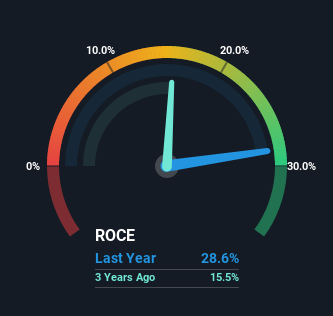- India
- /
- Professional Services
- /
- NSEI:BLS
Be Wary Of BLS International Services (NSE:BLS) And Its Returns On Capital

If you're looking for a multi-bagger, there's a few things to keep an eye out for. Typically, we'll want to notice a trend of growing return on capital employed (ROCE) and alongside that, an expanding base of capital employed. Put simply, these types of businesses are compounding machines, meaning they are continually reinvesting their earnings at ever-higher rates of return. So while BLS International Services (NSE:BLS) has a high ROCE right now, lets see what we can decipher from how returns are changing.
What Is Return On Capital Employed (ROCE)?
Just to clarify if you're unsure, ROCE is a metric for evaluating how much pre-tax income (in percentage terms) a company earns on the capital invested in its business. To calculate this metric for BLS International Services, this is the formula:
Return on Capital Employed = Earnings Before Interest and Tax (EBIT) ÷ (Total Assets - Current Liabilities)
0.29 = ₹1.9b ÷ (₹7.7b - ₹991m) (Based on the trailing twelve months to December 2022).
Thus, BLS International Services has an ROCE of 29%. In absolute terms that's a great return and it's even better than the Professional Services industry average of 12%.
See our latest analysis for BLS International Services

In the above chart we have measured BLS International Services' prior ROCE against its prior performance, but the future is arguably more important. If you'd like to see what analysts are forecasting going forward, you should check out our free report for BLS International Services.
How Are Returns Trending?
In terms of BLS International Services' historical ROCE movements, the trend isn't fantastic. To be more specific, while the ROCE is still high, it's fallen from 43% where it was five years ago. Although, given both revenue and the amount of assets employed in the business have increased, it could suggest the company is investing in growth, and the extra capital has led to a short-term reduction in ROCE. And if the increased capital generates additional returns, the business, and thus shareholders, will benefit in the long run.
On a related note, BLS International Services has decreased its current liabilities to 13% of total assets. So we could link some of this to the decrease in ROCE. What's more, this can reduce some aspects of risk to the business because now the company's suppliers or short-term creditors are funding less of its operations. Some would claim this reduces the business' efficiency at generating ROCE since it is now funding more of the operations with its own money.
What We Can Learn From BLS International Services' ROCE
In summary, despite lower returns in the short term, we're encouraged to see that BLS International Services is reinvesting for growth and has higher sales as a result. And the stock has done incredibly well with a 390% return over the last five years, so long term investors are no doubt ecstatic with that result. So while the underlying trends could already be accounted for by investors, we still think this stock is worth looking into further.
If you're still interested in BLS International Services it's worth checking out our FREE intrinsic value approximation to see if it's trading at an attractive price in other respects.
If you'd like to see other companies earning high returns, check out our free list of companies earning high returns with solid balance sheets here.
Valuation is complex, but we're here to simplify it.
Discover if BLS International Services might be undervalued or overvalued with our detailed analysis, featuring fair value estimates, potential risks, dividends, insider trades, and its financial condition.
Access Free AnalysisHave feedback on this article? Concerned about the content? Get in touch with us directly. Alternatively, email editorial-team (at) simplywallst.com.
This article by Simply Wall St is general in nature. We provide commentary based on historical data and analyst forecasts only using an unbiased methodology and our articles are not intended to be financial advice. It does not constitute a recommendation to buy or sell any stock, and does not take account of your objectives, or your financial situation. We aim to bring you long-term focused analysis driven by fundamental data. Note that our analysis may not factor in the latest price-sensitive company announcements or qualitative material. Simply Wall St has no position in any stocks mentioned.
About NSEI:BLS
BLS International Services
Provides outsourcing and administrative task of visa, passport, and consular services to various diplomatic missions.
Outstanding track record with excellent balance sheet.
Similar Companies
Market Insights
Community Narratives



